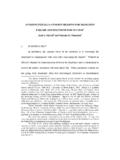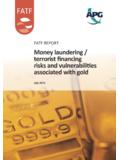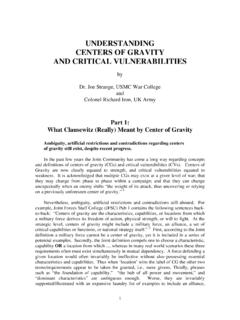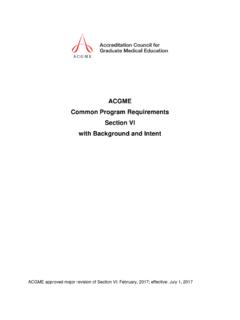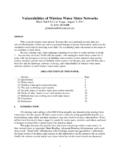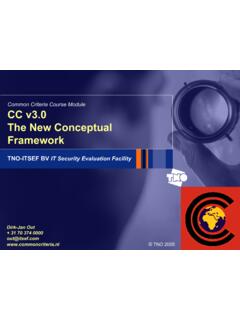Transcription of Money Laundering vulnerabilities of Free Trade …
1 Financial Action Task ForceGroupe d action financi re FATF Report Money Laundering vulnerabilities of free Trade Zones March 2010 THE FINANCIAL ACTIONTASK FORCE (FATF) The Financial Action Task Force (FATF) is an independent inter governmental body that develops and promotes policies to protect the global financial system against Money Laundering and terrorist financing. Recommendations issued by the FATF define criminal justice and regulatory measures that should be implemented to counter this problem. These Recommendations also include international co operation and preventive measures to be taken by financial institutions and others such as casinos, real estate dealers, lawyers and accountants. The FATF Recommendations are recognised as the global anti Money Laundering (AML) and counter terrorist financing (CFT) standard. For more information about the FATF, please visit the website: 2010 FATF/OECD.
2 All rights reserved No reproduction or translation of this publication may be made without prior written permission. Applications for such permission, for all or part of this publication, should be made to the FATF Secretariat, 2 rue Andr Pascal 75775 Paris Cedex 16, France (fax +33 1 44 30 61 37 or e mail: contact@fatf ). Money Laundering vulnerabilities of free Trade Zones March 2010 J TABLE OF CONTENTS EXECUTIVE SUMMARY .. 4 CHAPTER 5: CONCLUSION AND POLICY CONSIDERATIONS .. 27 ANNEX B: COMPLIATION OF BEST PRACTICES AND RECOMMENDATIONS .. 34 CHAPTER 1: INTRODUCTION .. 6 Need for the Typology .. 6 Scope .. 6 Methodology .. 6 CHAPTER 2: THE ROLE AND SCOPE OF free Trade ZONES .. 8 Definition .. 8 9 Privatization .. 13 CHAPTER 3: vulnerabilities OF free Trade ZONES .. 15 Application of AML/CFT measures in free Trade Zones .. 15 Relaxed Oversight and Lack of Transparency.
3 16 Lack of Systems Coordination .. 17 Vulnerable Types of Goods .. 17 CHAPTER 4: free Trade ZONES AS A METHOD USED BY ILLICT ACTORS .. 19 Predicates .. 19 Trade Based Money Laundering .. 19 Case Studies .. 20 REFERENCES .. 30 ANNEX A: ML/TF RISK INDICATORS .. 31 2010 FATF/OECD 3 J Money Laundering vulnerabilities of free Trade Zones March 2010 EXECUTIVE SUMMARY 1. free Trade Zones (FTZs) have proliferated in recent years, such that today there are approximately 3 000 FTZs1 in 135 countries around the world with a total turnover in the billions of FTZs are designated areas within jurisdictions in which incentives are offered to support the development of exports, foreign direct investment (FDI), and local employment. These incentives include exemptions from duty and taxes, simplified administrative procedures, and the duty free importation of raw materials, machinery, parts and equipment.
4 In addition to boosting economic opportunity, these incentives can result in a reduction in finance and Trade controls and enforcement, creating opportunities for Money Laundering and the financing of terrorism. Because the same characteristics that make FTZs attractive to legitimate business also attract abuse by illicit actors, FTZs are a concern that the Financial Action Task Force (FATF) should address. 2. The case studies included in this report illustrate ways in which FTZs are misused for Money Laundering and terrorist financing. In particular, the cases highlight the following systemic weaknesses that make FTZs vulnerable to abuse: Inadequate anti- Money Laundering (AML) and combating the financing of terrorism (CFT) safeguards; Relaxed oversight by competent domestic authorities; Weak procedures to inspect goods and register legal entities, including inadequate record-keeping and information technology systems; and Lack of adequate coordination and cooperation between zone and Customs authorities.
5 3. Further examination of the vulnerabilities highlighted in the case studies allowed for the development of ML/TF risk indicators related to financial transactions, unusual business activity, and Trade -based Money Laundering (TBML) which takes place within FTZs. 4. Although this is the first global report to address FTZs, this is not the first time that the Money Laundering and terrorist financing vulnerabilities of FTZs have been identified. Through the work of the Caribbean Financial Action Task Force (CFATF) and Aruba a number of best practice elements have been 1 The geographic area in which special regulatory and tax treatment is applied to certain Trade -related products and services, which in this paper is referred to as a free Trade zone, is also known by various other names throughout the world, including.
6 free zones, freeport zones, port free Trade zones, foreign Trade zones, e-zones, duty free Trade zones, commercial free Trade zones, export processing zones, logistic zones, Trade development zones, industrial zones/parks/areas, hi-tech industry parks, hi-tech and neo-tech industrial development zones, investment zones, bonded zones, special economic zones, economic development zones, economic and technological development zones, resource economic development zones and border economic cooperation zones. 2 Akinci, G. and Crittle, J. (2008). 4 2010 FATF/OECD Money Laundering vulnerabilities of free Trade Zones March 2010 J developed. The World Customs Organization, the only global standard setter of free Trade zones, has also developed reference tools for the development of FTZs. Finally, the FATF TBML Typologies and Best Practices Papers3 published in 2006 and 2008 respectively presented red flag indicators and best practices relevant to FTZs.
7 5. The misuse of free Trade zones impacts all jurisdictions including those without FTZs of their own, because goods can originate from or be transhipped through FTZs not subject to adequate export controls. Proliferators of weapons of mass destruction (WMD) abuse FTZs to tranship dual use goods and to disguise the final destination of sensitive items. FTZs can also be used to create legal entities and access the international financial system, providing opportunities to launder illicit proceeds. Many major zones are also located in regional financial centres linking international Trade hubs with access to global centres of finance. 6. free Trade zones are central to the integrated global economy. They stimulate economic growth and play a central role in business for many countries and leading manufacturers. The relevance of FTZs continues to grow as globalization defines economic progress.
8 However the standards, oversight, and regulations governing FTZs have not kept pace with these developments. As a result, illicit actors have been able to take advantage of relaxed oversight and the lack of transparency in zones to launder the proceeds of crime, finance terrorism, and facilitate WMD proliferation. 3 See 2010 FATF/OECD 5 J Money Laundering vulnerabilities of free Trade Zones March 2010 CHAPTER 1: INTRODUCTION Need for the Typology 7. free Trade zones (FTZs) present a unique Money Laundering and terrorist financing threat because of their special status within jurisdictions as areas where certain administrative and oversight procedures are reduced or eliminated in order to boost economic growth through Trade . Jurisdictions throughout the world create these designated areas, which go by many names.
9 For the purposes of this paper, these areas are referred to as FTZs. The special tax and administrative arrangements available to exporters and export service providers in FTZs, although intended to boost legitimate Trade , can create Money Laundering and terrorist financing vulnerabilities . 8. Other typologies reports have addressed related vulnerabilities , notably the Trade Based Money Laundering (TBML) typology report and TBML Best Practices Paper published in June 2006 and June 2008 respectively. While these reports were instructive, they did not fully address the vulnerabilities nor the scope of techniques utilized by illicit actors in part because they did not take into account the estimated 3 000 FTZs that play a significant role in global Trade and which attract substantial funds that are associated with cross-border transactions.
10 Scope 9. This report presents the first completed attempt at the international level to identify and address the Money Laundering and terrorist financing vulnerabilities of FTZs. The report also addresses potential shortcomings in the FATF s current AML/CFT framework. 10. The objectives of this typology report are to: Understand the size, scope, definition, and role of FTZs worldwide and their role in the global economy; Identify the Money Laundering and terrorist financing threats and vulnerabilities associated with FTZs; Identify the methods used to move and launder the proceeds of crime and/or finance terrorism using FTZs; and Suggest areas for further consideration to improve the AML/CFT framework concerning FTZs. Methodology 11. In preparing this report, the project team utilized a number of resources.











